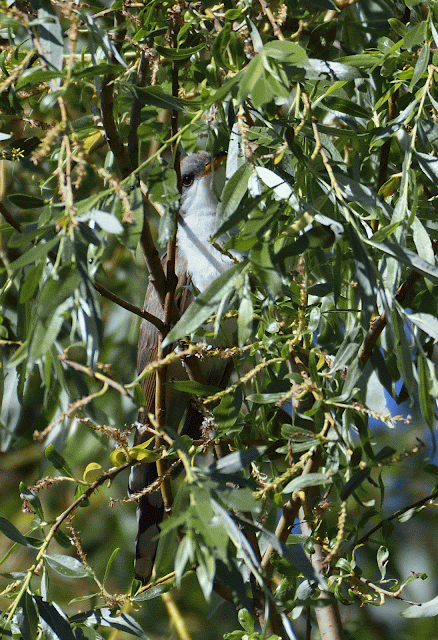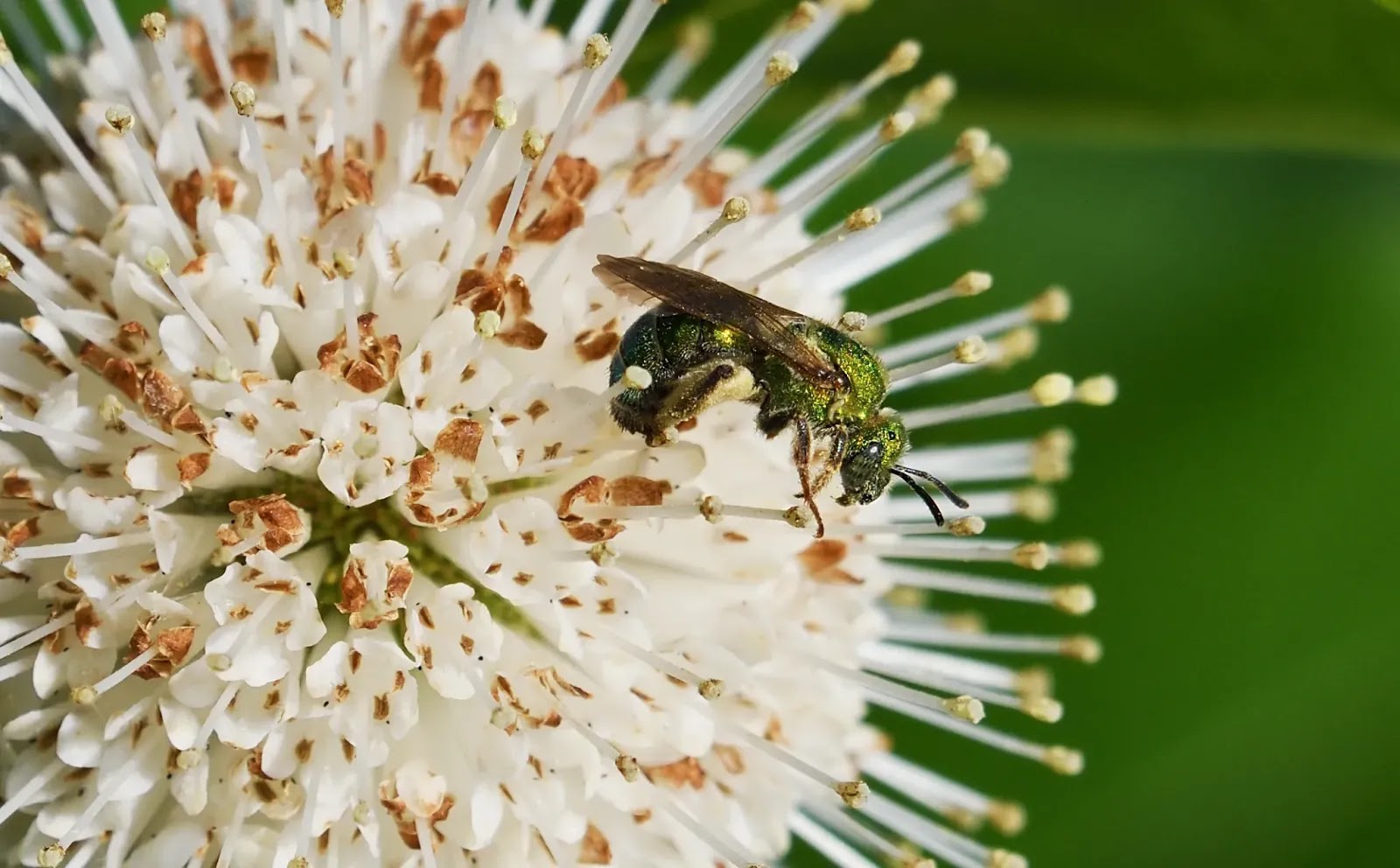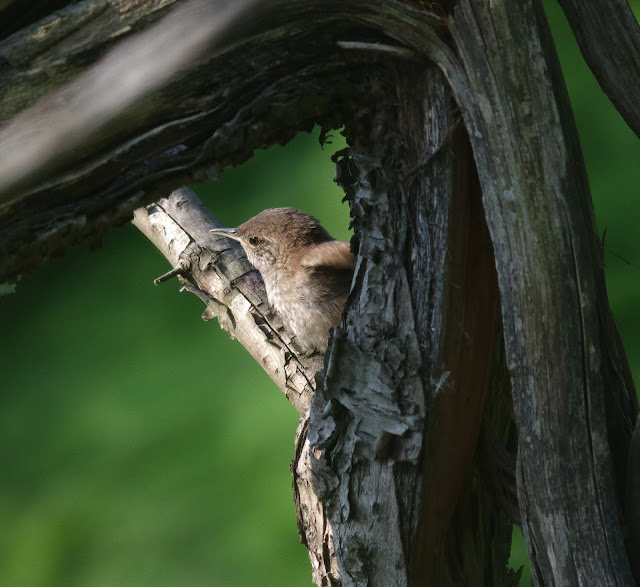A Bit of a Mouthful
For a week or so now I have been aware of an unusual croaking noise coming from way up high in the trees. I had been unable to locate the owner of the croaking. And even though the sound did appear to move from tree to tree, I never saw any movement, or was that perhaps because it was one communicating with another? Some kind of tree frog maybe, or was I possibly starting to lose my mind?
I was not going crazy and I did finally catch up with the owner of the croaking noise a few days ago, more by chance than anything else. I was in position, neatly hidden in the undergrowth as I waited for a northern flicker to return to its nesting hole. And then I saw it, partially hidden, high up in the leaves of a willow tree. It possessed a really long tail that was broken with patches of white, a curved beak and a definitive line under its eye separating the colours on its head. The only bird that sprang to mind of being anything remotely like that was a bee-eater, but that was impossible.
It was quite some distance away from me. I hoped that a least one of my photos would be in focus.
It was incredibly camera shy, even at that distance, and every time that I jostled for a better position, it would again move to stay hidden.
This was all the bird would allow me to see.
And there were spiders with really long legs.
There were caterpillars. Green ones.
Squishy ones.
And some that were pretending to look like twigs.
A few flies.
And there were moths.
Lots of moths and most were quite plain.
But the occasional one would show some different markings.
Some kind of larva that looks a little like a moth without wings.
Perhaps viewing from another angle will help.
Nope, I'm afraid my knowledge of entomology is far worse than my understanding of Canadian birds. Following on in that theme, I will refer to the next insect as a bug!
I actually think that I can identify the next insect. A European invader, a crane fly.
It was of course not just the house wrens who were busy collecting food. A downy woodpecker was also collecting grubs to take back to its young.
A female red-winged blackbird with a mouthful of tasty morsels for her fledglings.
But the prize for the most insects carried in their mouths has to go to the song sparrows.
And obviously, what goes in, must at some point come out. Not messy at all though, deposited in a perfect little fecal sac for the parent birds to remove from the nest.
Constantly on the move, the house wrens were nonstop with their supply of food.
One final photo of the house wrens as one of the parents again set off in pursuit of their chick's next meal.
That was to be the last photo for this post, but I simply had to return when the opportunity of a better photograph presented itself.
A very unfamiliar call caught my attention on the morning of the 28th of June. It caused me to backtrack to the bottom of Shoemaker Lake, from where I was very happy to snatch this photo of the yellow-billed cuckoo.
Copyright © wildlakeside.blogspot.com 2020 Scott Atkinson All Rights Reserved.
I was not going crazy and I did finally catch up with the owner of the croaking noise a few days ago, more by chance than anything else. I was in position, neatly hidden in the undergrowth as I waited for a northern flicker to return to its nesting hole. And then I saw it, partially hidden, high up in the leaves of a willow tree. It possessed a really long tail that was broken with patches of white, a curved beak and a definitive line under its eye separating the colours on its head. The only bird that sprang to mind of being anything remotely like that was a bee-eater, but that was impossible.
It was quite some distance away from me. I hoped that a least one of my photos would be in focus.
It was incredibly camera shy, even at that distance, and every time that I jostled for a better position, it would again move to stay hidden.
This was all the bird would allow me to see.
With the bird being so far away and partially obscured by the willow tree's leaves, I did not know if I had captured anything of worth. In fact, I uploaded the raw images from my camera that day to my computer as usual and then forgot about them completely. Until a conversation with my parents jogged my memory. One lucky photo captured the bird in its entirety, frozen as it almost flew out of the top corner of the original image. My Cornell app again proved useful in identifying a rare find and another bird to add to my list at Lakeside Park. It is a yellow-billed cuckoo!
A little bit of interesting information about this bird: it is one of the few birds able to eat the hairy caterpillars that most other birds avoid. Being a cuckoo I would expect that it would lay its eggs in other birds nests, but yellow-billed cuckoos also nest and rear their own young, although they will occasionally lay eggs in the nests of others. Their colloquial name is the "rain crow" as they are often heard responding to the sound of thunder with that croaking call which I mentioned earlier.
Such a cool bird and I am very happy to add it to my list.
And now, to the title of this post. Summer is definitely moving on at a pace and many of the parent birds are incredibly busy with the feeding of their hungry offspring. I decided to keep an eye on a family of house wrens to see just what they were managing to find at Lakeside Park to bring home for their young to eat.
I'll start with the spiders. There were spiders with short legs.
And there were spiders with really long legs.
Squishy ones.
And some that were pretending to look like twigs.
A few flies.
And there were moths.
Lots of moths and most were quite plain.
But the occasional one would show some different markings.
Some kind of larva that looks a little like a moth without wings.
Perhaps viewing from another angle will help.
Nope, I'm afraid my knowledge of entomology is far worse than my understanding of Canadian birds. Following on in that theme, I will refer to the next insect as a bug!
It was of course not just the house wrens who were busy collecting food. A downy woodpecker was also collecting grubs to take back to its young.
A female red-winged blackbird with a mouthful of tasty morsels for her fledglings.
But the prize for the most insects carried in their mouths has to go to the song sparrows.
With its mouth jammed to the brim with a licorice allsorts looking mixture of flies and grubs, this song sparrow definitely takes first place.
And obviously, what goes in, must at some point come out. Not messy at all though, deposited in a perfect little fecal sac for the parent birds to remove from the nest.
Constantly on the move, the house wrens were nonstop with their supply of food.
One final photo of the house wrens as one of the parents again set off in pursuit of their chick's next meal.
That was to be the last photo for this post, but I simply had to return when the opportunity of a better photograph presented itself.
A very unfamiliar call caught my attention on the morning of the 28th of June. It caused me to backtrack to the bottom of Shoemaker Lake, from where I was very happy to snatch this photo of the yellow-billed cuckoo.
Copyright © wildlakeside.blogspot.com 2020 Scott Atkinson All Rights Reserved.


























Comments
Post a Comment